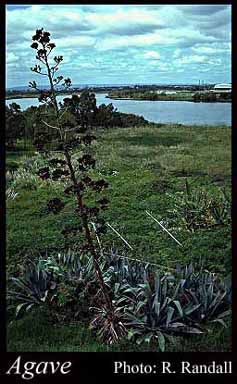- Reference
- Sp.Pl. [Linnaeus] 2:323 (1753)
- Name Status
- Current







Scientific Description
Family Agavaceae.
Habit and leaf form. Large herbs, or ‘arborescent’ (with rosettes of large, tough, fleshy, wax-coated leaves, usually with short, thick stems, rarely with a woody trunk); evergreen. Plants succulent, or non-succulent. Perennial (of 5–60 years life-span). Leaves basal (rosette). Plants with a basal concentration of leaves, or with terminal rosettes of leaves (when shrubby or arborescent). Young stems very short, rarely a woody trunk. Rhizomatous. Pachycaul. Xerophytic. Leaves small to very large; alternate (crowded, ‘indeterminate’); spiral; leathery, or fleshy, or leathery and fleshy; sessile; sheathing; edgewise to the stem, or with ‘normal’ orientation; simple; epulvinate. Leaf blades entire; flat, or solid; linear, or lanceolate, or subulate; ovate (to lanceolate); parallel-veined (commonly obscure); without cross-venules. Leaves without stipules. Leaf blade margins entire, or serrate (spine-pointed). Leaves with a persistent basal meristem, and basipetal development. Vegetative anatomy. Plants without silica bodies. Leaf anatomy. Hairs absent. Extra-floral nectaries absent. Stem anatomy. Secondary thickening anomalous; from a single cambial ring.
Reproductive type, pollination. Fertile flowers hermaphrodite. Unisexual flowers absent. Plants hermaphrodite (generally protandrous).
Inflorescence and flower features. Flowers aggregated in ‘inflorescences’; in umbels (or umbellate clusters), or in racemes, or in spikes, or in panicles. The terminal inflorescence unit cymose (but often condensed). Inflorescences scapiflorous; terminal; the inflorescence large, scapose and occasionally bulbiliferous, the flowering stem growing rapidly up to 7 m. Flowers pedicellate; bracteate (on the scape); ebracteolate; regular to somewhat irregular; when irregular, somewhat zygomorphic; 3 merous; cyclic; pentacyclic. Perigone tube present. Perianth of ‘tepals’; 6; 2 -whorled; isomerous; joined; petaloid; similar in the two whorls. Fertile stamens present. Androecial members definite in number. Androecium 6. Androecial members adnate (to the perianth tube); all equal; free of one another; 2 -whorled. Androecium exclusively of fertile stamens. Stamens 6 (in 2 whorls); all more or less similar in shape; diplostemonous; on the base of the perianth tube. Anthers versatile; dehiscing via longitudinal slits; usually introrse; tetrasporangiate. Pollen shed in aggregates, or shed as single grains; occasionally in tetrads. Fertile gynoecium present. Gynoecium 3 carpelled. The pistil 3 celled. Gynoecium syncarpous; eu-syncarpous; inferior. Ovary plurilocular; 3 locular. Gynoecium stylate. Styles 1; apical. Stigmas 3; 3 - lobed. Placentation axile. Ovules 20–50 per locule (numerous); anatropous.
Fruit and seed features. Fruit fleshy, or non-fleshy; dehiscent; a capsule. Capsules loculicidal. Fruit 20–100 seeded (many). Seeds endospermic. Endosperm oily. Cotyledons 1. Embryo straight. Testa encrusted with phytomelan.
Geography, cytology, number of species. Holarctic and Neotropical. World distribution: widespread.
Economic uses, etc. Pulque and mescal derive from fermentation/distillation of Agave sap; and many yield useful fibres (sisal hemp, henequen, pita, istle, ixtle, lechuguilla, keratto, etc.).
Additional comments. Flowers only once, dies after fruit ripen.
Etymology. From the Greek for "noble or admirable".
Taxonomic Literature
- Marchant, N. G.; Wheeler, J. R.; Rye, B. L.; Bennett, E. M.; Lander, N. S.; Macfarlane, T. D.; Western Australian Herbarium 1987. Flora of the Perth region. Part one. Western Australian Herbarium.. [Perth]..